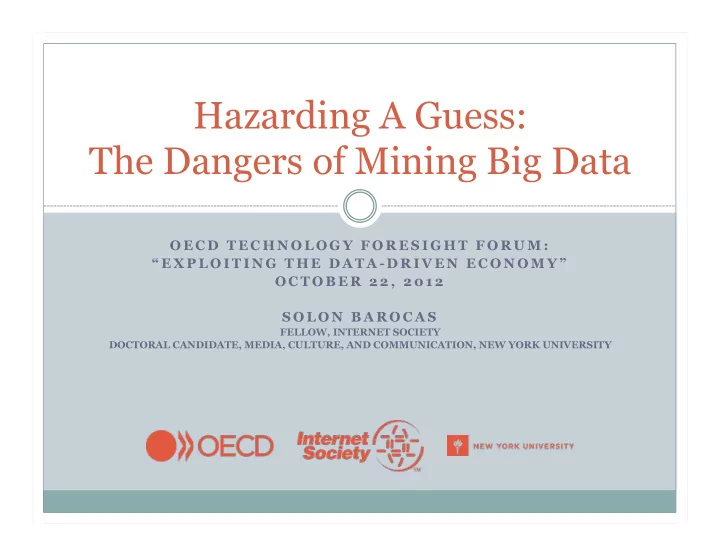

Hazarding A Guess: The Dangers of Mining Big Data O E C D T E C H N O L O G Y F O R E S I G H T F O R U M : “ E X P L O I T I N G T H E D A T A - D R I V E N E C O N O M Y ” O C T O B E R 2 2 , 2 0 1 2 S O L O N B A R O C A S FELLOW, INTERNET SOCIETY DOCTORAL CANDIDATE, MEDIA, CULTURE, AND COMMUNICATION, NEW YORK UNIVERSITY
Tail Wagging the Dog Evidence-based policy vs. policy-making based on evidence ¡ A bias toward policy-making for which there is more easily accessible and cheaply obtainable evidence More than the rationalization of an existing, more ad hoc procedure; instead, Big Data may change the activity to which it is brought to bear ¡ e.g., education in the United States… ¡ e.g., the profound change policing experienced with the introduction of profiling: from a general concern with crime reduction (efficacy) to a narrower concern with the likelihood that each police action would result in crime detection (efficiency) (Harcourt 2007) ¡ “anyone who is committing the same crime should face the same likelihood of being punished” ÷ Fairness ÷ Rule of law
Optimization Problems Some obvious problems that Big Data pose the FIPPs… But some quite technical issues that are not yet well appreciated ¡ Tension between fairness and accuracy ÷ Purging illegal—but relevant—features from the model reduces the predictive accuracy of the model ¢ Ironically, correcting for latent discrimination requires collecting precisely those pieces of information that are verboten ¡ Tension between transparency and accuracy ÷ In many cases, complex models tend to be more accurate than those that are more parsimonious ÷ But the added complexity renders them inscrutable
The Cost of Non-Erroneous and Lawful Discrimination Discriminatory by design ¡ Non-erroneous discrimination? ¡ Lawful discrimination? ÷ Absence of animus ÷ Not involving protected class Fairness (Gandy 2009) ¡ To sort and evaluate to better target and tailor interventions ÷ Produce unequal access to information, goods, and services Equity and Inequality (Gandy 1993) ¡ Constrain life chances ¡ Exacerbate historical disparities Ratchet effect (Harcourt 2007) ¡ Stratification ¡ Stigmatization
Substantive Regulations Supplement privacy with other normative concerns ¡ Autonony ¡ Non-discrimiantion ¡ Fairness But this might necessitate a shift from procedural fairness to distributive justice ¡ The challenges of developing rigorous technical definitions (Dwork et al. 2012)
Recommend
More recommend